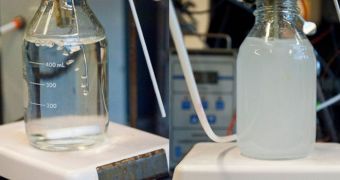For many years, researchers around the world have been looking for various methods of removing carbon from the air and then storing it away, and now experts at MIT have developed a groundbreaking solution to this problem.
A team of experts has developed a new technique that allows for the dangerous greenhouse gas carbon dioxide (CO2) to be trapped inside a chemical with which it reacts to create something useful.
Unlike other carbon capture and storage (CCS) methods, this one turns the substance into solid carbonates, which can then be used as construction material for new project.
In the past, CCS proposals advocated the creation of technologies that would trap the gas as it leaves smokestacks, and then store it away underground, or inside caves, basically sweeping the issue under a very big rug.
But the new approach proves that thinking outside the box is helpful. The idea was developed by Angela Belcher, who is an engineer at the Massachusetts Institute of Technology (MIT).
The work she and her team conducts is of paramount importance for our planet's future, given that excessive CO2 releases have been proven to cause global warming, and also climate change.
Official statistics show that the world emits about 20 billion metric tons of CO2 into the air yearly, and this vast amount of contaminants is beginning to overwhelm Earth's natural “sponges.”
The most important sponges for CO2 are the ocean (through phytoplankton blooms) and rainforests.
Slowly, accumulations of carbonic acid – a byproduct of chemical interactions between H2O and CO2 – are turning the waters acidic, changing their pH levels.
Capturing even a small amount of this vast quantity of carbon dioxide, and then converting it into construction materials could have significant implications for the world.
“We want to capture carbon dioxide and not put it underground, but turn it into something that will be stable for hundreds of thousands of years,” explains the team leader, who is also the W.M. Keck Professor of Energy at MIT.
Working together with graduate students Roberto Barbero and Elizabeth Wood, Belcher managed to genetically engineer common strands of baker's yeast so that they facilitate the production of carbonates when carbon dioxide is added.
According to the experts, lab tests revealed that subjecting a single pound of CO2 to this process can result in the production of two pounds of carbonate. Scaling up the process is now the main challenge.
“We’re trying to mimic natural biological processes, [but] we don’t necessarily want to make the exact same structure that an abalone [a microorganism] does,” Belcher reveals.

 14 DAY TRIAL //
14 DAY TRIAL //